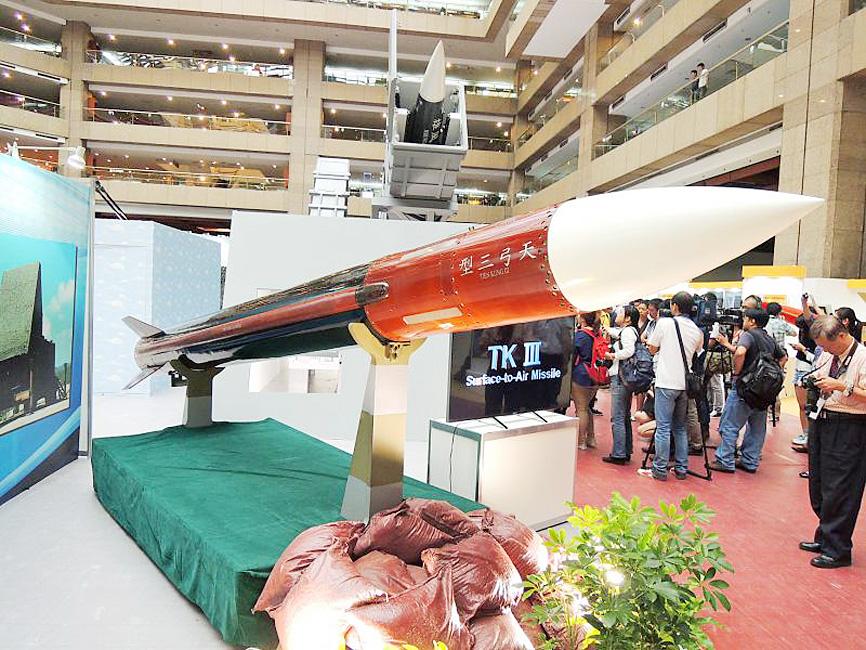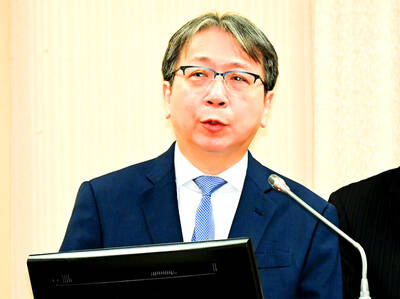Taiwan is developing missiles that can attack enemy air bases and bring down cruise missiles, and drones that can target their firing locations, a report by the military-owned body making the weapons said.
Taiwan last year approved NT$240 billion (US$8.2 billion) in extra military spending over the next five years as tensions with China have hit a new high and Chinese military planes have repeatedly flown through Taiwan’s air defense identification zone.
Taiwan plans to more than double its annual missile production capacity to close to 500 this year, the Ministry of National Defense said last month, as it boosts its combat power.

Photo: Lo Tien-pin, Taipei Times
In a report to the Legislative Yuan this week, a copy of which was reviewed by Reuters, the Chungshan Institute of Science and Technology offered more details of what the missiles and drones it is developing could do in a war.
The Hsiung Sheng land-attack missile, which experts say could have a range of up to 1,000km, comes in two versions: one with a high-explosive warhead to hit bunkers and hardened command centers, and the other with “dispersal” munitions to take out airfield facilities, it said.
Chieh Chung (揭仲), a researcher at the Taipei-based National Policy Foundation, said the Hsiung Sheng could reach most bases under the Chinese People’s Liberation Army’s Eastern Theatre Command, including those near Shanghai and the province of Zhejiang.
“It could greatly boost the national army’s capacity to delay or paralyze the communist forces’ pace of an invasion of Taiwan, making it hard for them to achieve a rapid war,” he said.
The advanced Sky Bow III surface-to-air missile is designed to take down ballistic and cruise missiles, as well as fighter jets.
Taiwan’s plans predate Russia’s invasion of Ukraine, but the war has prompted conversations about the lessons Taiwan could apply to fighting off a Chinese attack, including how Ukraine has resisted a numerically superior force.
One Taiwan-based Western security source said that although Taiwan was getting gear such as Harpoon anti-ship missiles from the US, its own missile program would help ensure the country would not have to rely on foreign supplies, as Ukraine has.
“It’s a hedging strategy,” the source said, speaking on condition of anonymity.
The institute said that drones, which Ukraine has used to great effect against Russia’s military, could attack enemy missile launch sites or act as decoys to help pinpoint enemy radars.
Four new facilities, including bases and repair plants, would be built by 2025 for the new drones, it said.
The ministry has previously announced plans to start manufacturing unspecified “attack drones,” with an annual production target of 48 such aircraft.
Little has been disclosed about the domestically produced drones. The first batch of US-made MQ-9 Reaper drones, which can be armed with missiles and operate at long range, is to enter service by 2025, the ministry said last month.
About 64 percent of Taiwan’s extra military spending, which came on top of planned military spending of NT$471.7 billion for next year, is to be spent on anti-ship weapons, such as land-based missile systems, including a NT$148.9 billion plan to mass produce homegrown missiles and “high-performance” ships.

The US government has signed defense cooperation agreements with Japan and the Philippines to boost the deterrence capabilities of countries in the first island chain, a report by the National Security Bureau (NSB) showed. The main countries on the first island chain include the two nations and Taiwan. The bureau is to present the report at a meeting of the legislature’s Foreign Affairs and National Defense Committee tomorrow. The US military has deployed Typhon missile systems to Japan’s Yamaguchi Prefecture and Zambales province in the Philippines during their joint military exercises. It has also installed NMESIS anti-ship systems in Japan’s Okinawa

TRAGEDY STRIKES TAIPEI: The suspect died after falling off a building after he threw smoke grenades into Taipei Main Station and went on a killing spree in Zhongshan A 27-year-old suspect allegedly threw smoke grenades in Taipei Main Station and then proceeded to Zhongshan MRT Station in a random killing spree that resulted in the death of the suspect and two other civilians, and seven injured, including one in critical condition, as of press time last night. The suspect, identified as a man surnamed Chang Wen (張文), allegedly began the attack at Taipei Main Station, the Taipei Fire Department said, adding that it received a report at 5:24pm that smoke grenades had been thrown in the station. One man in his 50s was rushed to hospital after a cardiac arrest

‘WIN-WIN’: The Philippines, and central and eastern European countries are important potential drone cooperation partners, Minister of Foreign Affairs Lin Chia-lung said Minister of Foreign Affairs Lin Chia-lung (林佳龍) in an interview published yesterday confirmed that there are joint ventures between Taiwan and Poland in the drone industry. Lin made the remark in an exclusive interview with the Chinese-language Liberty Times (the Taipei Times’ sister paper). The government-backed Taiwan Excellence Drone International Business Opportunities Alliance and the Polish Chamber of Unmanned Systems on Wednesday last week signed a memorandum of understanding in Poland to develop a “non-China” supply chain for drones and work together on key technologies. Asked if Taiwan prioritized Poland among central and eastern European countries in drone collaboration, Lin

ON ALERT: Taiwan’s partners would issue warnings if China attempted to use Interpol to target Taiwanese, and the global body has mechanisms to prevent it, an official said China has stationed two to four people specializing in Taiwan affairs at its embassies in several democratic countries to monitor and harass Taiwanese, actions that the host nations would not tolerate, National Security Bureau (NSB) Director-General Tsai Ming-yen (蔡明彥) said yesterday. Tsai made the comments at a meeting of the legislature’s Foreign Affairs and National Defense Committee, which asked him and Minister of National Defense Wellington Koo (顧立雄) to report on potential conflicts in the Taiwan Strait and military preparedness. Democratic Progressive Party (DPP) Legislator Michelle Lin (林楚茵) expressed concern that Beijing has posted personnel from China’s Taiwan Affairs Office to its